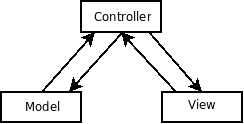Model view controller
The Model View Controller (MVC) is one of the oldest architectural patterns. It is still widely used in web and application programming.
The general premise is to separate an application into three distinct parts:
- Model: The underlying model of the data, this is often provided by a back-end database.
- View: The interface with the web client/browser or the application's GUI.
- Controller: The logic (sometimes called 'business logic') that interfaces between the view and the model. In OO terms, the "controller offers facilities to change the state of the model."
The MVC is often considered circular in form, with the model providing data for the view, which uses the controller to update the model. However, in some situations the controller is thought to sit between the view and the model.
Ward's wiki considers both of these options incorrect [1]. The controller should simply exist to promote communication and validation between the model and the view. It should provide ways to change the view, either through direct calls or the use of an Observer. Controversy exists on whether the MVC should be considered an OO design pattern at all.
Contents |
Patterns
So, lets consider the variations of MVC.
MVC-Observer-Strategy
MVC-Mediator
- Controller resembles the Mediator between Model and View
MVC as an Input-Output Process
The diagram above shows how MVC can be viewed as a slight deviation from the OO paradigm. This is one way to argue that MVC is not OO [2].
External links
- Model View Controller - What Ward's wiki has to say about the MVC
- MVC's OO Nature - A discussion on Ward's wiki as to whether the MVC is appropriate or even valid for OOD.
- GUI Architectures by Martin Fowler


